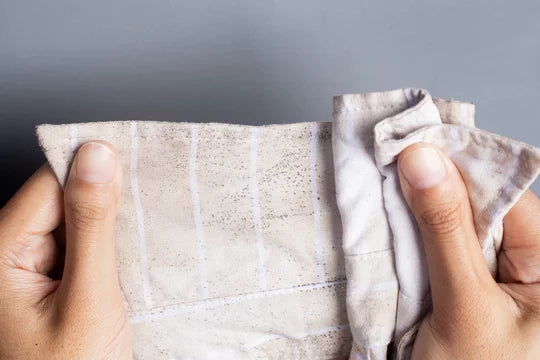How to Get Mould Out of Fabric: A Step-by-Step Guide


Mould, a common term for microscopic fungi, poses significant risks to the aesthetics of fabrics and human health. These minute life forms typically breed on damp materials in cool and dark environments, gradually decomposing organic matter like fabric fibres. Due to their minute size, mould spores can attach themselves easily to material surfaces, effortlessly turning harmless presences into infestations if left unchecked.
According to Dr. Aaron Glatt at Mount Sinai Medical Center, a specialist in infectious diseases, "Mold exposure has been linked with allergies, causing symptoms ranging from nasal stuffiness or throat irritation with coughing." The Centers for Disease Control and Prevention (CDC) further advises that certain individuals might experience more serious reactions like fever and shortness of breath when exposed over longer periods.
Time is of the essence when dealing with mould-affected fabrics. A meta-analysis published by NIH concluded that Residential dampness and mould are associated with substantial and statistically significant increases in respiratory infections and bronchitis.
This guide will elucidate step-by-step instructions on instantaneously removing moulds using effectual household products readily available while prioritising safety precautions.

Certainly, mould can be expunged from fabric with appropriate cleaning. Initially, brush off loose mould outdoors to avoid indoor contamination. Soak the items in a vinegar-baking soda solution, breaking down stubborn spores before laundering them as usual. If severe infestation persists and if bleach is safe for the fabric type, bleach provides an effective countermeasure. Complete drying under natural sunlight post-cleaning is crucial, as it helps thwart residual fungal growth.
Recognize mould presence on fabrics through distinct signs such as brownish-green stains and a sour smell. Observing these early indicators helps prompt prompt action, limiting the spread.
Personal safety is paramount when handling mold-contaminated items. Wear gloves, goggles, and protective clothing to avoid direct contact or inhalation of harmful spores during the cleaning process, safeguard overall well-being throughout the treatment procedure, and source protection gear readily available within the household.
The degree of contamination dictates the appropriate solution type, ranging from milder vinegar-baking soda mixtures suitable for light infestations, whereas severe cases necessitate robust commercial cleaners containing bleach, ensuring thorough eradication of stubborn growths, thereby restoring affected items' original state effectively.
If resorting to homemade remedies, pre-soak articles in a calculated mixture ratio, allowing effective penetration into fabric fibres and disrupting fungal structures. Subsequently, scrub off gently using a toothbrush specifically dedicated to assisting the dislodgement of resilient colonies, facilitating an easier removal wash cycle.

After initial surface cleaning, proceed towards the exhaustive laundry, conducting the highest temperature permissible dictated by the care label, preventing potential damage to delicate fabrics while attaining the required degree of cleanliness and making sure residues get flushed out entirely during the rigorous washing phase, leaving behind thoroughly cleaned garments at the end of session devoid of any foul odours lingering contaminants initially present.
An essential post-cleaning aspect involves drying laundered objects under warm sunlight characterized by natural disinfectant properties helping maintain mould-free status, further enhanced powerful radiation emitted acting as the final barrier against surviving remnants yet striving to multiply despite preceding aggressive anti-fungal treatments implemented.
Clean up wisely, discard remaining solutions in an eco-friendly manner, preserve environmental quality, sterilize reusable equipment before storage, and prevent accidental cross-contamination in upcoming usage instances if ever needed.
Post-treatment, remain vigilant for signs of regrowth—recurrent dampness or returning odours might indicate unresolved underlying moisture issues. Ensure fabric remains dry, reducing susceptibility to future mould invasions, significantly contributing to healthier living spaces and maintaining aesthetic appeal. Personal belongings truly render them dearer in more ways.
In essence, mould removal necessitates early identification, adequate protection, suitable cleaning methods, and meticulous aftercare. Rigorous washing followed by sun drying ensures complete elimination, while vigilance helps prevent future outbreaks, maintaining healthier living spaces and preserving textile aesthetics.
How do you remove mould from fabric?
Removing mould from fabric involves brushing off loose spores, soaking the item in a vinegar-baking soda solution or using commercial cleaners if needed, and then laundering and sun drying.
What is a homemade Mould remover for fabric?
A homemade mould remover for fabric consists of white vinegar mixed with baking soda. Soak the affected cloth in it before washing thoroughly.
How do you remove mould from a fabric sofa?
To remove mould from a fabric sofa, vacuum superficial growth initially followed by applying appropriate cleaning solutions generously on infested areas; scrub gently yet effectively till patches disappear, eventually concluding with thorough air-drying under sunlight if circumstances permit doing so without damaging material involved.
What removes mould?
White vinegar or bleach-based products are usually effective at removing mould. Both break down fungal structures upon application, making subsequent removal much easier during the rinse cycle, restoring items to their original condition and ultimately devoid of any foul odour characteristic moulds apart from visible staining generally seen.










Plus get the inside scoop on our latest content and updates in our monthly newsletter.